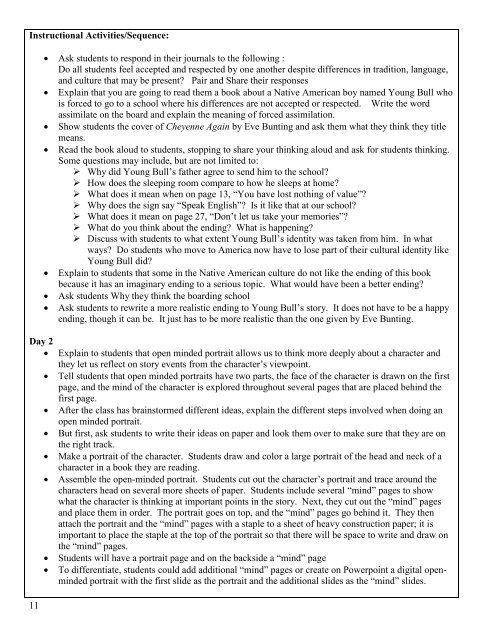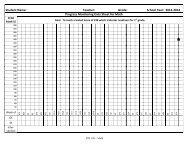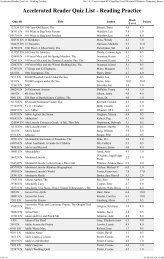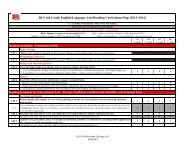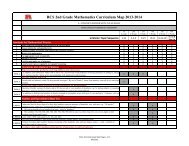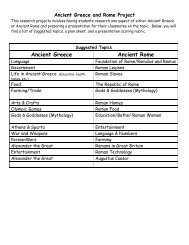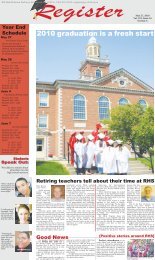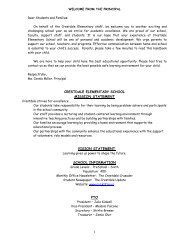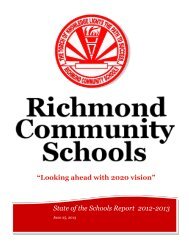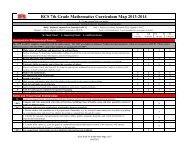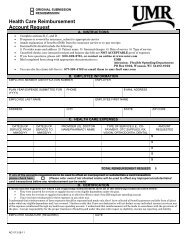Ubd Unit Indian Boarding Schools.pdf - Richmond Community Schools
Ubd Unit Indian Boarding Schools.pdf - Richmond Community Schools
Ubd Unit Indian Boarding Schools.pdf - Richmond Community Schools
Create successful ePaper yourself
Turn your PDF publications into a flip-book with our unique Google optimized e-Paper software.
Instructional Activities/Sequence:<br />
Ask students to respond in their journals to the following :<br />
Do all students feel accepted and respected by one another despite differences in tradition, language,<br />
and culture that may be present? Pair and Share their responses<br />
Explain that you are going to read them a book about a Native American boy named Young Bull who<br />
is forced to go to a school where his differences are not accepted or respected. Write the word<br />
assimilate on the board and explain the meaning of forced assimilation.<br />
Show students the cover of Cheyenne Again by Eve Bunting and ask them what they think they title<br />
means.<br />
Read the book aloud to students, stopping to share your thinking aloud and ask for students thinking.<br />
Some questions may include, but are not limited to:<br />
‣ Why did Young Bull’s father agree to send him to the school?<br />
‣ How does the sleeping room compare to how he sleeps at home?<br />
‣ What does it mean when on page 13, “You have lost nothing of value”?<br />
‣ Why does the sign say “Speak English”? Is it like that at our school?<br />
‣ What does it mean on page 27, “Don’t let us take your memories”?<br />
‣ What do you think about the ending? What is happening?<br />
‣ Discuss with students to what extent Young Bull’s identity was taken from him. In what<br />
ways? Do students who move to America now have to lose part of their cultural identity like<br />
Young Bull did?<br />
Explain to students that some in the Native American culture do not like the ending of this book<br />
because it has an imaginary ending to a serious topic. What would have been a better ending?<br />
<br />
<br />
Ask students Why they think the boarding school<br />
Ask students to rewrite a more realistic ending to Young Bull’s story. It does not have to be a happy<br />
ending, though it can be. It just has to be more realistic than the one given by Eve Bunting.<br />
Day 2<br />
<br />
<br />
<br />
<br />
<br />
<br />
<br />
<br />
Explain to students that open minded portrait allows us to think more deeply about a character and<br />
they let us reflect on story events from the character’s viewpoint.<br />
Tell students that open minded portraits have two parts, the face of the character is drawn on the first<br />
page, and the mind of the character is explored throughout several pages that are placed behind the<br />
first page.<br />
After the class has brainstormed different ideas, explain the different steps involved when doing an<br />
open minded portrait.<br />
But first, ask students to write their ideas on paper and look them over to make sure that they are on<br />
the right track.<br />
Make a portrait of the character. Students draw and color a large portrait of the head and neck of a<br />
character in a book they are reading.<br />
Assemble the open-minded portrait. Students cut out the character’s portrait and trace around the<br />
characters head on several more sheets of paper. Students include several “mind” pages to show<br />
what the character is thinking at important points in the story. Next, they cut out the “mind” pages<br />
and place them in order. The portrait goes on top, and the “mind” pages go behind it. They then<br />
attach the portrait and the “mind” pages with a staple to a sheet of heavy construction paper; it is<br />
important to place the staple at the top of the portrait so that there will be space to write and draw on<br />
the “mind” pages.<br />
Students will have a portrait page and on the backside a “mind” page<br />
To differentiate, students could add additional “mind” pages or create on Powerpoint a digital openminded<br />
portrait with the first slide as the portrait and the additional slides as the “mind” slides.<br />
11


